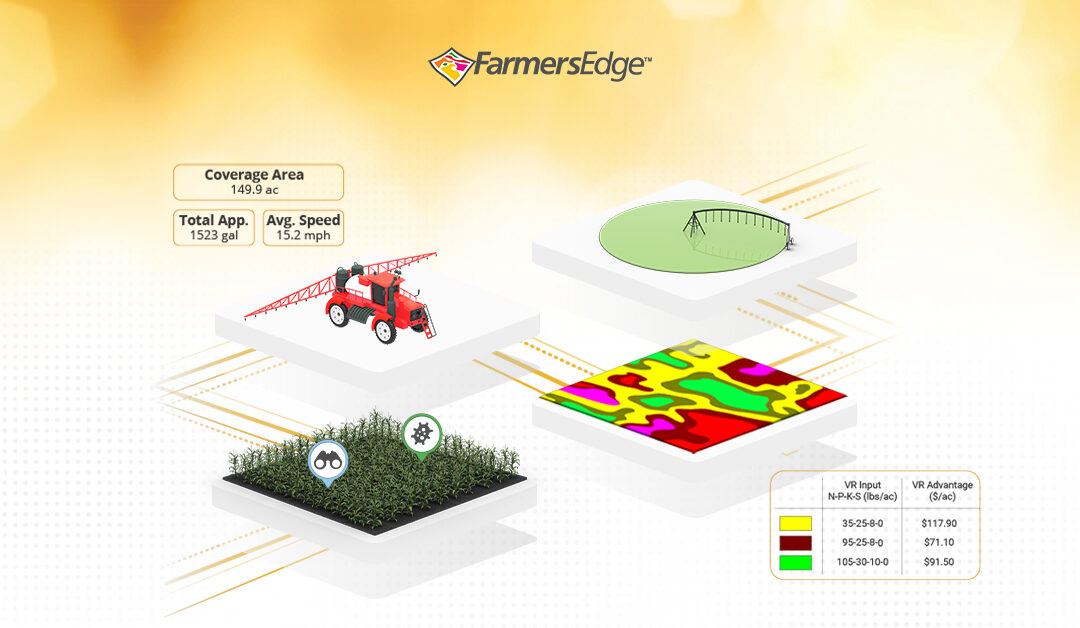By: Shane Thomas, Global Digital Ag Lead
Variable Rate Technology (VRT) has been used in western Canadian agriculture for the last two decades with significant success: increased yields, higher profitability, lower costs and more efficient harvests. Over the last handful of years, VRT has improved even more, expanding through to all crop types. The resolution at which we can create prescription maps has increased to a new level of precision, helping farmers to understand how much to place and where to achieve the best results. And now because of the effectiveness being recognized industry-wide, Sask Ag has put together a Farm Stewardship Program for variable rate mapping—to encourage the use of zone maps for variable rate fertilizer and irrigation applications with significant funding for farmers who implement in.
The biggest use case for VRT is in fertilizer. Fertilizer often ranges from 35-50% of total variable input costs! Today, there are still studies showing that the main nutrient used, nitrogen, has a use efficiency in western Canada that is not anywhere near 100%. That means, depending on the application method, there is a significant amount of leaching or gassing off that occurs, therefore wasting inputs. Through variable rate application, we can increase this use efficiency by putting the nitrogen in the areas of the field that have the highest likelihood of response.
In order to know where the optimal area of the field is, we need to do a combination of things, including soil testing in conjunction with high-resolution satellite imagery. Assessing the highest production areas in combination with understanding the biological, physical and chemical makeup of those areas informs experts on the best application rates based on crop and yield potential for farm customers.
What is it?
The Farm Stewardship Program assists producers with funding to implement beneficial farm management practices in priority areas such as water quality, climate change and biodiversity. This specific Variable Rate BMP program is focused on assisting farmers in obtaining zone maps for variable rate fertilizer and variable rate irrigation applications.
According to the Government of Saskatchewan website, a BMP is defined as any agricultural management practice that:
- ensures the long-term health and sustainability of land-related resources used for agricultural production;
- positively impacts the long-term economic and environmental viability of agricultural production; and
- minimizes negative impacts and risks to the environment.
The opportunity is open to Saskatchewan farmers who are either currently using variable rate fertilizer and variable rate irrigation applications or are planning to use it next season. Through this BMP, producers can more cost-effectively reduce their environmental impacts to soil and water resources and decrease greenhouse gas emissions.
What is the dollar value?
The funding is for 30 percent of mapping costs to a maximum of $2,000. The maximum eligible cost for variable rate mapping is $8 per acre. This is retroactive, meaning if you have had mapping done in the past two years, dating back to April 1st of 2018, you are eligible to receive this reimbursement.
Steps to enroll
1. Go to the link here on the Saskatchewan Government website.
2. Determine eligibility:
- Primary producers who earn a minimum of $50,000 of gross farm income in Saskatchewan.
- Producers who own, lease or rent property where livestock and poultry are grown, bred, kept, raised, displayed, assembled or disposed of require a Saskatchewan Premises Identification.
- Must have an Environmental Farm Plan Certificate (EFPC) or other sustainability initiatives, such as Verified Beef Production Plus (VBP+), 4R Nutrient Stewardship or an International Sustainability and Carbon Certificate (ISCC).
3. Complete an Environmental Farm Plan (EFP) or 4R Nutrient Stewardship Plan:
- Access the EFP here. Any producer can complete this plan, and once completed it will be submitted to the Ministry’s Agriculture Knowledge Center, where a specialist will review it. Upon approval, an Environmental Farm Plan Certificate is issued.
- 4R Nutrient Stewardship Plan. 4R Nutrient Stewardship provides a framework to help crop-producers minimize environmental concerns related to agriculture while maximizing economic benefits using the Right Source at the Right Rate, Right Time, and Right Place®. Visit Fertilizer Canada for more details or contact your Farmers Edge representative to learn more about developing a plan.
4. Fill out an application.
- Producers can submit an application for a rebate to the Programs Branch.
5. Talk with your Farmers Edge representative about zone-based VR practices that qualify for the program.
- Farmers Edge representatives would be happy to support you at any point in the process as well as in filling out any of the required forms. There has never been a better time to try out Variable Rate Technology. At Farmers Edge, we service more acres of variable rate in Canada than anyone else and back our services with measurable results.


